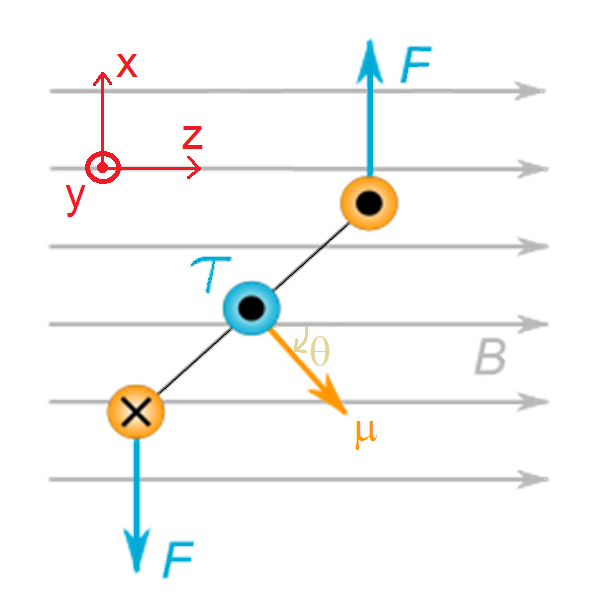Magnetic Torque
Claimed by Demetria Hubbard--Dhubbard8 (talk) 15:02, 2 December 2015 (EST)
Magnetic torque is a phenomenon that occurs when the magnetic field produced causes a current-carrying wire to twist out of proportion.
The Main Idea
The idea behind this concept is that as the current flows through the wire and a magnetic field is produced. While this magnetic field is being produced, there is a force acting upon the wire causing it to twist. An example of this phenomenon is the movement of a compass needle by the Earth's magnetic field or hanging a coil near a bar magnet will cause it to twist in the direction of the magnetic field.
A Mathematical Model
Torque is created from the magnetic forces acting upon a coil.
 This is the overall equation for determining magnetic torque.
This is the overall equation for determining magnetic torque.
![]() Represents torque (in units of N*m)
Represents torque (in units of N*m)
![]() is the dipole moment of the magnet (A*m^^2)
is the dipole moment of the magnet (A*m^^2)
![]() is the magnetic field created by the magnet (in units of Tesla)
is the magnetic field created by the magnet (in units of Tesla)
A Computational Model
How do we visualize or predict using this topic. Consider embedding some vpython code here Teach hands-on with GlowScript
Examples
Torque on Current Carrying Loop
Simple
A bar magnet whose magnetic dipole moment is <3, 0, 1.8> A · m2 is suspended from a thread in a region where external coils apply a magnetic field of <0.6, 0, 0> T. What is the vector torque that acts on the bar magnet?
Middling
A bar magnet whose magnetic dipole moment is 14 A · m2 is aligned with an applied magnetic field of 5.4 T. How much work must you do to rotate the bar magnet 180° to point in the direction opposite to the magnetic field?
Difficult
Connectedness
Utilizing a compass is a basic survival need and it just so happens to depend on the torque produced by the Earth's magnetic field. As a Biology major, field work is a large part of what I do, especially studying ecological systems and different habitats. In order to navigate in unfamiliar locations, such as deserts and dense tropical forests, scientists rely heavily on basic survival skills and this includes the use of compasses and maps. Physics, biology, and chemistry make up part of the science family and each heavily depends on the other, this is why it is important to study each one to bridge the relationship.
History
Picture of scientist goes here
Who? What? When? Where? Why?
See also
Further reading
- Chabay, Ruth W., and Bruce A. Sherwood. Matter & Interactions. 3rd ed. Hoboken, NJ: Wiley, 2011. Print.
External links
References
- Torque Example
- Chabay, Ruth W., and Bruce A. Sherwood. Matter & Interactions. 3rd ed. Hoboken, NJ: Wiley, 2011. Print.



